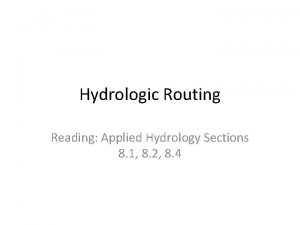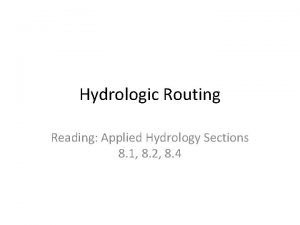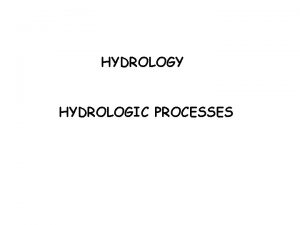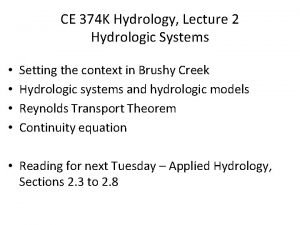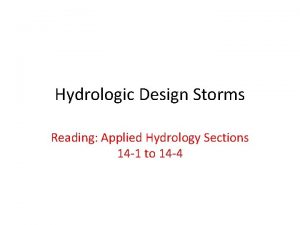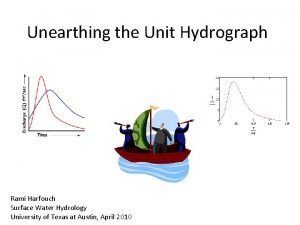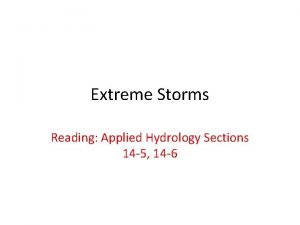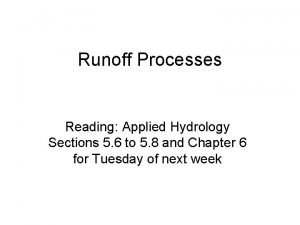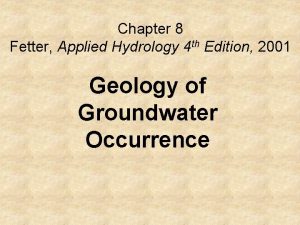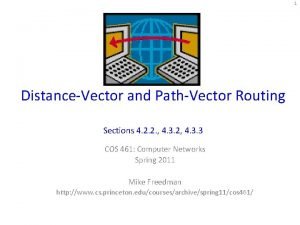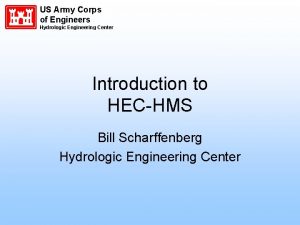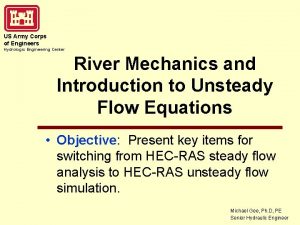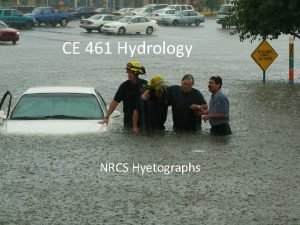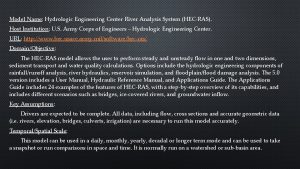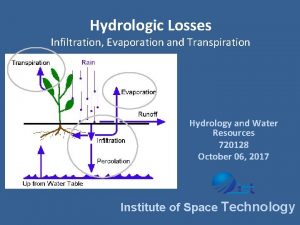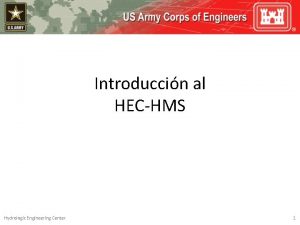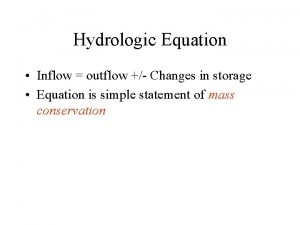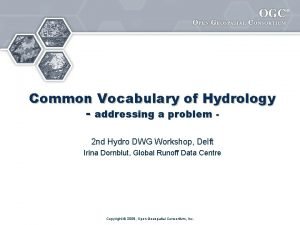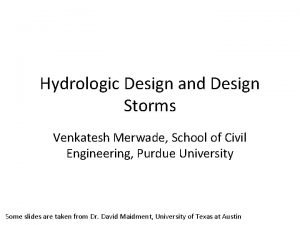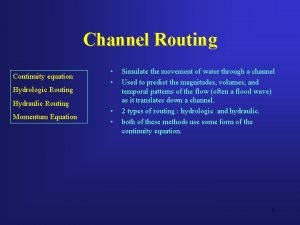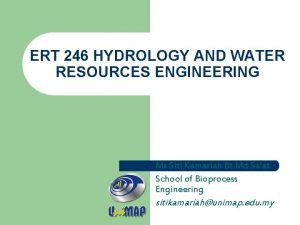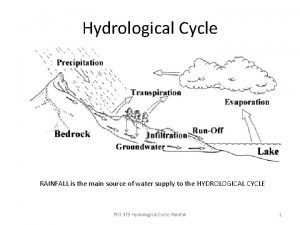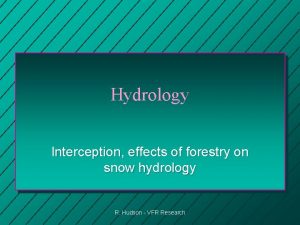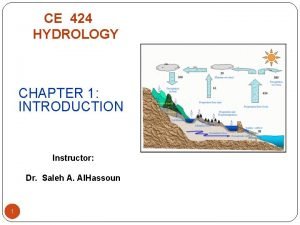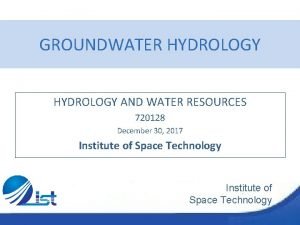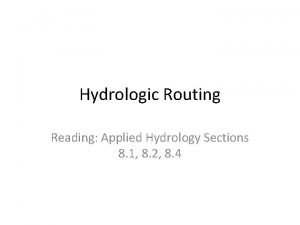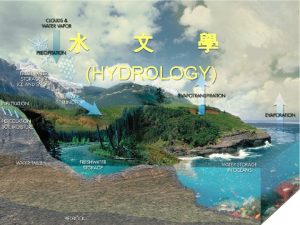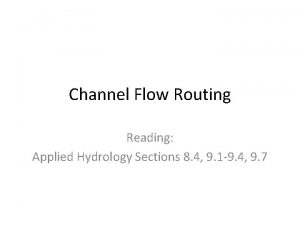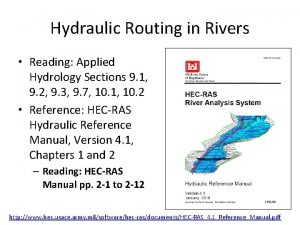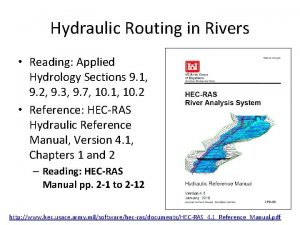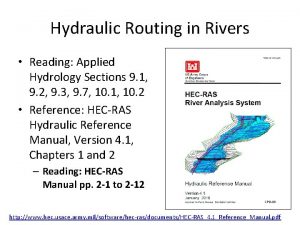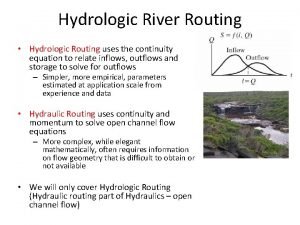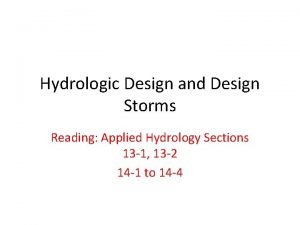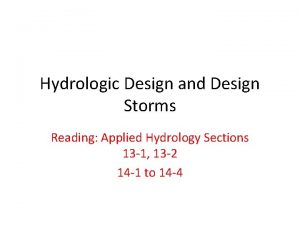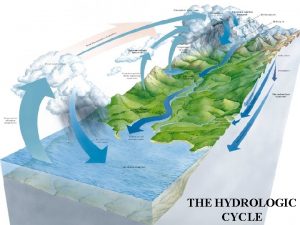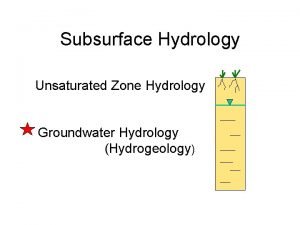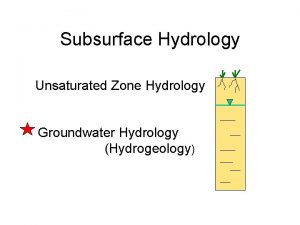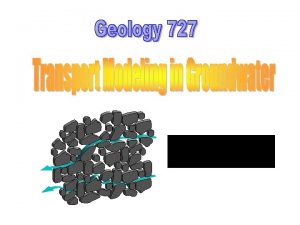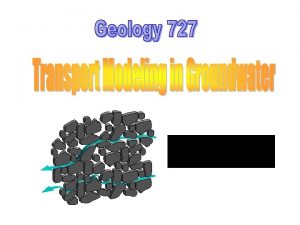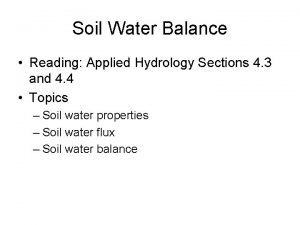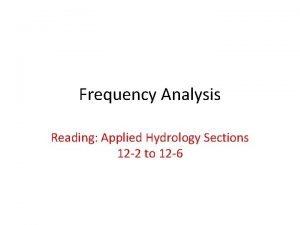Hydrologic Routing Reading Applied Hydrology Sections 8 1


































- Slides: 34

Hydrologic Routing Reading: Applied Hydrology Sections 8. 1, 8. 2, 8. 4

Flow Routing Q t • Procedure to determine the flow hydrograph at a point on a watershed from a known hydrograph upstream • As the hydrograph travels, it – attenuates – gets delayed Q t Q t 2

Why route flows? Q t n n Account for changes in flow hydrograph as a flood wave passes downstream This helps in n n Accounting for storages Studying the attenuation of flood peaks 3

Watershed – Drainage area of a point on a stream Rainfall Streamflow Connecting rainfall input with streamflow output

Flood Control Dams Dam 13 A Flow with a Horizontal Water Surface

Floodplain Zones 1% chance < 0. 2% chance Main zone of water flow Flow with a Sloping Water Surface

Types of flow routing • Lumped/hydrologic – Flow is calculated as a function of time alone at a particular location – Governed by continuity equation and flow/storage relationship • Distributed/hydraulic – Flow is calculated as a function of space and time throughout the system – Governed by continuity and momentum equations 7

Hydrologic Routing Discharge Inflow Transfer Function Downstream hydrograph Upstream hydrograph Input, output, and storage are related by continuity equation: Q and S are unknown Storage can be expressed as a function of I(t) or Q(t) or both For a linear reservoir, S=k. Q Outflow 8

Lumped flow routing • Three types 1. Level pool method (Modified Puls) – Storage is nonlinear function of Q 2. Muskingum method – Storage is linear function of I and Q 3. Series of reservoir models – Storage is linear function of Q and its time derivatives 9

S and Q relationships 10

Level pool routing • Procedure for calculating outflow hydrograph Q(t) from a reservoir with horizontal water surface, given its inflow hydrograph I(t) and storage-outflow relationship 11

Level pool methodology Discharge Inflow Outflow Time Storage Unknown Need a function relating 12 Time Storage-outflow function Known

Level pool methodology • Given – Inflow hydrograph – Q and H relationship • Steps 1. Develop Q versus Q+ 2 S/Dt relationship using Q/H relationship 2. Compute Q+ 2 S/Dt using 3. Use the relationship developed in step 1 to get Q 13

Ex. 8. 2. 1 Given I(t) Given Q/H Area of the reservoir = 1 acre, and outlet diameter = 5 ft 14

Ex. 8. 2. 1 Step 1 Develop Q versus Q+ 2 S/Dt relationship using Q/H relationship 15

Step 2 Compute Q+ 2 S/Dt using At time interval =1 (j=1), I 1 = 0, and therefore Q 1 = 0 as the reservoir is empty Write the continuity equation for the first time step, which can be used to compute Q 2 16

Step 3 Use the relationship between 2 S/Dt + Q versus Q to compute Q Use the Table/graph created in Step 1 to compute Q What is the value of Q if 2 S/Dt + Q = 60 ? So Q 2 is 2. 4 cfs Repeat steps 2 and 3 for j=2, 3, 4… to compute Q 3, Q 4, Q 5…. . 17

Ex. 8. 2. 1 results 18

Ex. 8. 2. 1 results Outflow hydrograph Inflow Peak outflow intersects with the receding limb of the inflow hydrograph Outflow 19

Q/H relationships http: //www. wsi. nrcs. usda. gov/products/W 2 Q/H&H/Tools_Models/Sites. html 20 an NRCS Reservoir Program for Routing Flow through

HEC-HMS Model of Brushy Creek Walsh D Dam 7

Dam 7, Upper Brushy Creek

Dam 7 836 ft 829 ft 805 ft HEC-HMS representation

Elevation-Storage Curve, Dam 7 Top of Dam, 836 Emergency Spillway, 829

Storage-Discharge Curve, Dam 7 Emergency Top of Spillway, 829 Dam, 836

Dam 7 Hydrologic Simulation

Hydrologic river routing (Muskingum Method) Wedge storage in reach Advancing Flood Wave I>Q K = travel time of peak through the reach X = weight on inflow versus outflow (0 ≤ X ≤ 0. 5) X = 0 Reservoir, storage depends on outflow, no wedge X = 0. 0 - 0. 3 Natural stream Receding Flood Wave Q>I

Muskingum Method (Cont. ) Recall: Combine: If I(t), K and X are known, Q(t) can be calculated using above 28 equations

Muskingum - Example • Given: – Inflow hydrograph – K = 2. 3 hr, X = 0. 15, Dt = 1 hour, Initial Q = 85 cfs • Find: – Outflow hydrograph using Muskingum routing method 29

Muskingum – Example (Cont. ) C 1 = 0. 0631, C 2 = 0. 3442, C 3 = 0. 5927 30

HEC-HMS Model of Brushy Creek Walsh D Dam 7

Watershed W 1820

Junction J 329 W 1820 R 580 J 329 W 1820

Reach R 580
 Hydrologic routing and hydraulic routing
Hydrologic routing and hydraulic routing Hydrologic routing
Hydrologic routing Lumped flow routing
Lumped flow routing Reservoir flood routing worked examples
Reservoir flood routing worked examples Applied hydrology
Applied hydrology Applied hydrology
Applied hydrology Hyteograph
Hyteograph Applied hydrology
Applied hydrology Applied hydrology
Applied hydrology Applied hydrology
Applied hydrology Applied hydrology
Applied hydrology Distance vector routing algorithm
Distance vector routing algorithm Clock and power routing in vlsi
Clock and power routing in vlsi Static routing and dynamic routing
Static routing and dynamic routing Pre reading while reading and post reading activities
Pre reading while reading and post reading activities Hydrologic engineering center
Hydrologic engineering center Hydrologic abstractions
Hydrologic abstractions Water cycle the hydrologic cycle
Water cycle the hydrologic cycle Hydrologic engineering center
Hydrologic engineering center Objectiveable
Objectiveable River analysis system
River analysis system Infiltration
Infiltration Hydrology continuity equation
Hydrology continuity equation Hydrologic engineering center
Hydrologic engineering center Hydrologic equation
Hydrologic equation Advanced hydrology
Advanced hydrology International glossary of hydrology
International glossary of hydrology Design storm in hydrology
Design storm in hydrology Hydraulic routing methods
Hydraulic routing methods Meteorology hydrology and water management
Meteorology hydrology and water management In greek language hudor means *
In greek language hudor means * Quadrant method hydrology
Quadrant method hydrology Interception hydrology
Interception hydrology Qg 424
Qg 424 بئر ارتوازي
بئر ارتوازي

